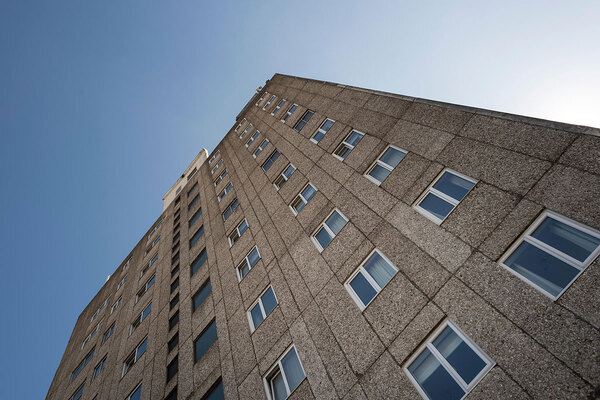Global Accounts: sector’s EBITDA MRI interest cover falls below 100 per cent
The sector’s EBITDA MRI interest cover dropped below 100 per cent in 2023-24 for the first time since the 2007-2008 financial crisis, data from the English regulator has shown.

The drop follows record spend on repairs and maintenance during the year.
The Regulator of Social Housing’s (RSH) Global Accounts showed that sector EBITDA MRI interest cover deteriorated by 15 percentage points from the previous year, to 88 per cent in 2023-24.
Cover below 100 per cent indicates that the increased cost of servicing debt exceeds net earnings after all repairs spend is deducted.
This is the first time the aggregate figure has dropped below this threshold since the 2007-2008 financial crisis.
However, the RSH highlighted that the low level of cover reported in 2007-08 was partially attributable to the number of providers undertaking stock improvement programmes following stock transfers.
Interest cover performance varies across the sector. In 2023-24, 34 per cent of providers reported interest cover of below 100 per cent, a rise from 30 per cent in the previous year and 23 per cent in 2021-22.
The Global Accounts showed that some of the largest organisations reported relatively low levels of interest cover and weaker metrics.
As a cohort, the 17 largest providers (all with more than 40,000 social units) had the lowest level of reported EBITDA MRI interest cover in 2023-24, at 73 per cent.
This group of large providers also reported high levels of spend on repairs and maintenance, particularly those landlords with “significant” levels of stock in London, the regulator said.
The fall in interest cover was attributed to a £500m (16 per cent) annual rise in total interest and finance costs and a record spend of £8.8bn on repairs and maintenance.
This investment was 13 per cent (£1bn) more than in the previous year (£7.7bn) and 55 per cent (£3.1bn) above the pre-pandemic level of £5.7bn reported in 2020. The record spending has resulted in the aggregate EBITDA MRI margin falling to below 16 per cent.
The increased investment in existing stock was driven by a focus on improving tenants’ homes, including fire remediation, building safety and energy efficiency measures. Projected spend on repairs and maintenance rose by 11 per cent year-on-year and is now equivalent to £10bn per annum over the next five years.
In addition, high levels of investment combined with weaker financial performance have also affected the level of cash and short-term investments held by the sector, which decreased by £800m (12 per cent) year-on-year to £5.5bn. This was the third year in a row in which the level of cash and short-term investments fell.
“Financial headroom and capacity to absorb downside risk is reduced across the sector,” the RSH said in its Global Accounts.
Providers are facing difficult trade-offs between maintaining financial resilience and investing in new and existing homes, with many scaling back their development ambitions due to investment in existing homes.
“Reduced financial headroom limits the sector’s ability to manage downside risk and means that some providers are making trade-offs in order to reduce their risk exposure and maintain their focus on their existing stock,” the RSH said.
“The regulator will continue to engage closely with providers where our analysis suggests that financial performance is weak and will reflect this in regulatory judgements. Where a provider identifies a potential problem with or threat to its viability, it is incumbent on them to give the regulator early warning.”
Falling surplus
As well as showing a drop in interest cover, the Global Accounts revealed that the sector’s combined surplus fell by 46 per cent to reach £2.3bn in 2023-24, down from £4.3bn in 2022-23. The report is based on providers’ consolidated financial statements.
The RSH said the reported surplus fluctuates year-on-year as a result of movements in fair value. For example, the financial results from providers that have undertaken mergers often include fair value gains from these partnerships.
The operating surplus on social housing lettings increased by £400m to reach £4.2bn, partially driven by a rise in the number of units but also reflecting a slight increase in the margin on this core activity. The majority of social housing lettings income (£16.5bn) was from rent.
Operating margin (excluding fixed asset sales), although remaining at historically low levels, increased slightly from 16.6 per cent to 16.9 per cent. Meanwhile, turnover climbed by £1.9bn to reach £19.3bn.
Receipts from market sales fell by 50 per cent annually, generating just £43m. This was equivalent to one per cent of the sector’s operating surplus and is the lowest level on record since the RSH started collecting consolidated financial data in 2015.
Excluding ‘non-cash’ fair value gains and losses, the underlying surplus generated by the sector fell from £2.2bn in 2022-23 to £1.6bn in 2023-24. The RSH put this down to higher interest rates pushing up the cost of debt and record levels of capitalised repair and maintenance expenditure.
Similarly, Social Housing’s accounts digest, published in November, revealed that pre-tax surplus for the UK fell nearly 40 per cent, although this covers a slightly different cohort of providers. The report showed that increases in interest payments and repairs costs, and decreased sales surpluses, both contributed, as did movements in valuations for organisations holding stock at market value.
“The regulator will continue to engage with providers where we have concerns over financial viability and covenant positions,” the RSH said.
The sector’s continued robust liquidity in aggregate allowed providers to raise the necessary funds to invest in their existing homes.
Providers agreed new facilities, including refinancing, of £12.5bn in the year and reported undrawn facilities of £29.9bn in March 2024.
Will Perry, director of strategy at the RSH, said: “The sector as a whole has so far proven resilient as it grapples with competing financial pressures, managing to stabilise operating margins this year while investing record amounts on existing homes and building much-needed new homes.
“However, forecasts indicate this could become more challenging in the future as rising levels of debt and cost of capital, as well as sustained high levels of investment in existing stock, impact providers’ surpluses.
“As these challenges intensify, providers must monitor and mitigate risks, including alerting us of any material issues. We will take action if we have concerns about a landlord’s viability.
“We know that this continued close scrutiny is key to maintaining investor confidence, as well as protecting tenants and providing new homes across the country.”
Sign up for Social Housing’s weekly news bulletin
Social Housing’s weekly news bulletin delivers the latest news and insight across finance and funding, regulation and governance, policy and strategy, straight to your inbox. Meanwhile, news alerts bring you the biggest stories as they land.
Already have an account? Click here to manage your newsletters.
RELATED








